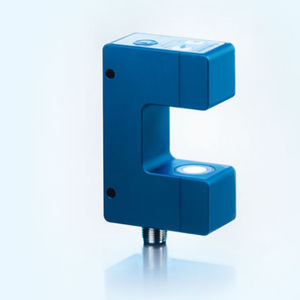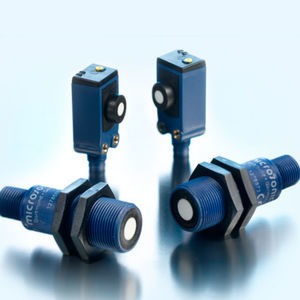
Ultrasonic label sensor esp-4 series

Add to favorites
Compare this product
Characteristics
- Options
- ultrasonic
Description
esp-4: Label and splice sensor compact in a single unit, optionally with M12 sensor heads.
Highlights
3 Teach-in methods to be able to configure the sensor individually for any task
Response time < 300 µs for use at high web and label speeds
QuickTeach simplified Teach-in process
Splice detection even for thick band materials
Variants with very compact transmitters and receivers in the M12 threaded sleeve
Basics
Label and splice sensor in a single unit
2 switching outputs for label/splice detection and web break monitoring
LinkControl as optional assistance for installation and commissioning
Description
With a rapid pulse sequence, an ultrasonic transmitter beams upwards against the backing material. The effect of the sound pulses inducing the backing material to vibrate is for a markedly weakened sonic wave to be emitted on the opposite side.
The receiver receives this sonic wave and analyses it. The backing material signal level is different to that of the label or splice. And this difference in signal is analysed by the esp-4. The difference between backing material and a label or between sheeting and splice can be very slight indeed. In order to differentiate, the esp-4 sensor has to learn the signal level for the backing material or sheeting.
The esp-4 sensors can be used as a label and splice sensor. The 3 Teach-in methods and QuickTeach allow the esp-4 sensor to be optimally set for each and every assignment.
A) Dynamic Teach-in of backing material and label
During Teach-in, the backing material with the labels is led at a constant speed through the esp-4 sensor. The esp-4 sensor automatically learns signal levels for the labels and for the gaps between them
VIDEO
Catalogs
esp-4 label/splice sensor
17 Pages
Online Catalogue ultrasonic sensors
172 Pages
Exhibitions
Meet this supplier at the following exhibition(s):

Related Searches
- Microsonic proximity sensor
- Cylindrical proximity switch
- Microsonic IP67 proximity sensor
- Industrial detector
- Microsonic distance sensor
- DC proximity switch
- Threaded proximity switch
- Plastic proximity switch
- Rectangular proximity switch
- PNP proximity switch
- Microsonic analog distance sensor
- M12 proximity switch
- Microsonic IP67 distance sensor
- Microsonic digital distance sensor
- Analog detector
- M18 proximity switch
- Cylindrical distance sensor
- Microsonic ultrasonic distance sensor
- Ultrasonic barrier
- M12 connector distance sensor
*Prices are pre-tax. They exclude delivery charges and customs duties and do not include additional charges for installation or activation options. Prices are indicative only and may vary by country, with changes to the cost of raw materials and exchange rates.









